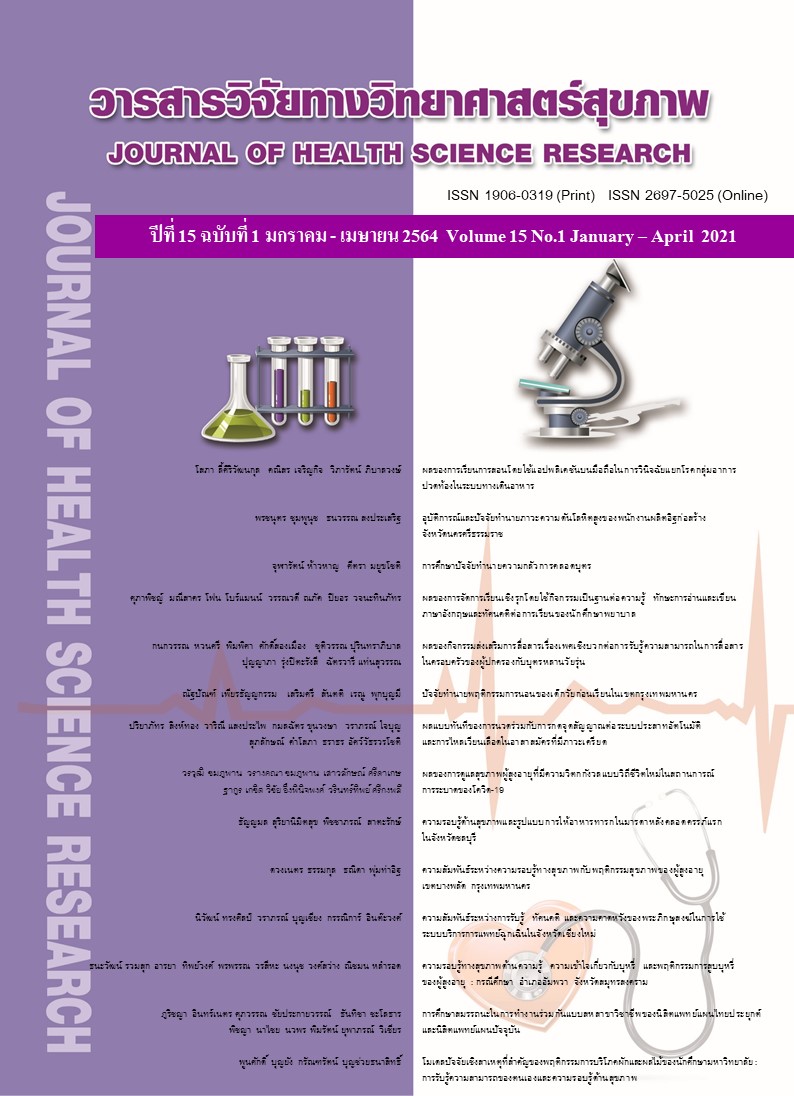ปัจจัยทำนายพฤติกรรมการนอนของเด็กวัยก่อนเรียน ในเขตกรุงเทพมหานคร
Main Article Content
บทคัดย่อ
บทนำ : การนอนเป็นกิจกรรมที่จำเป็นต่อร่างกายมนุษย์ โดยเฉพาะในเด็กวัยก่อนเรียนที่ร่างกายกำลังเจริญเติบโต การศึกษาปัจจัยที่มีผลกระทบต่อการนอนของเด็ก จะเป็นประโยชน์ในการส่งเสริมการเจริญเติบโตของเด็กวัยนี้ให้เหมาะสมตามวัย
วัตถุประสงค์การวิจัย : เพื่อหาปัจจัยทำนายพฤติกรรมการนอนของเด็กวัยก่อนเรียนในเขตกรุงเทพมหานคร
วิธีการวิจัย : การวิจัยเชิงทำนาย ตัวอย่าง คือ เด็กวัยก่อนเรียน ในเขตกรุงเทพมหานคร จำนวน 225 คน เครื่องมือที่ใช้ในการวิจัย ได้แก่ แบบสอบถามข้อมูลทั่วไป แบบสอบถามสิ่งแวดล้อมการนอน และแบบสอบถามพฤติกรรมการนอนหลับของเด็กฉบับภาษาไทย (ฉบับย่อ) ค่าสัมประสิทธิ์แอลฟาครอนบาค เท่ากับ .81 และ .80 ตามลำดับ วิเคราะห์ข้อมูลโดยใช้สถิติบรรยาย และการวิเคราะห์การถดถอยโลจิสติค
ผลการวิจัย : พบว่า ร้อยละ 80.40 ของเด็กมีพฤติกรรมการนอนไม่ดี และเมื่อควบคุมปัจจัยอื่นๆ ปัจจัยที่สามารถทำนายพฤติกรรมการนอนได้ ได้แก่ โรคติดเชื้อระบบทางเดินหายใจ และแสงที่จ้าเกินไป
โดยเด็กที่ป่วยเป็นโรคติดเชื้อระบบทางเดินหายใจบ่อยๆ มีโอกาสเกิดพฤติกรรมการนอนที่ไม่ดีมากกว่าเด็กที่มีการติดเชื้อน้อยกว่า 3 ครั้ง ในระยะเวลา 3 เดือน 8.8 เท่า (ORadj = 8.80; p < .05, 95%CI 1.13, 68.55) และเด็กที่นอนในแสงที่จ้าเกินไปมีโอกาสเกิดพฤติกรรมการนอนที่ไม่ดีมากกว่าเด็กที่ไม่เคยตื่นเนื่องจากแสงจ้า 9.98 เท่า (ORadj = 9.98; p < .05, 95%CI 1.09, 91.03)
สรุปผล : ควรส่งเสริมให้ผู้ดูแลเด็กมีความรู้ในการป้องกันการเกิดโรคติดเชื้อในระบบทางเดินหายใจในเด็ก และการจัดสิ่งแวดล้อมการนอนให้เหมาะสม เพื่อลดพฤติกรรมการนอนที่ไม่ดี
Downloads
Article Details
บทความที่ได้รับการตีพิมพ์เป็นลิขสิทธิ์ของวิทยาลัยพยาบาลบรมราชชนนี จังหวัดนนทบุรี
ข้อความที่ปรากฏในบทความแต่ละเรื่องในวารสารวิชาการเล่มนี้เป็นความคิดเห็นส่วนตัวของผู้เขียนแต่ละท่านไม่เกี่ยวข้องกับวิทยาลัยพยาบาลบรมราชชนนี จังหวัดนนทบุรี และคณาจารย์ท่านอื่น ในวิทยาลัยฯ แต่อย่างใด ความรับผิดชอบองค์ประกอบทั้งหมดของบทความแต่ละเรื่องเป็นของผู้เขียนแต่ละท่าน หากมีความผิดพลาดใด ๆ ผู้เขียนแต่ละท่านจะรับผิดชอบบทความของตนเองแต่ผู้เดียว
เอกสารอ้างอิง
Mindell JA, Owens JA. A clinical guide to pediatric sleep: diagnosis and management of sleep problems. Lippincott Williams & Wilkins; 2015.
Vriend JL, Davidson FD, Corkum PV, Rusak B, McLaughlin EN, Chambers CT. Sleep quantity and quality in relation to daytime functioning in children. Child Health Care. 2012;41(3):204–22. doi: 10. 1080/02739615.2012.685039.
Dewald JF, Meijer AM, Oort FJ, Kerkhof GA, Bögels SM. The influence of sleep quality, sleep duration and sleepiness on school performance in children and adolescents: A meta-analytic review. Sleep Med Rev. 2010;14(3):179–89. doi: 10.1016/j.s mrv.2009.10.004.
Simola P, Liukkonen K, Pitkäranta A, Pirinen T, Aronen ET. Psychosocial and somatic outcomes of sleep problems in children: A 4-year follow-up study. Child Care Health Development. 2014;40(1):60 –7. doi: 10.1111/j.1365-2214.2012.01412.x
Könen T, Dirk J, Leonhardt A, Schmiedek F. The interplay between sleep behavior and affect in elementary school children’s daily life. J Exp Child Psychol. 2016;150:1–15. doi: 10.1016/ j.jecp.2016.04.003.
Division of Innovation and Research (DIR). Disease Prevention, Disease Control, and Health Hazard Research Program 2019-2021. Ministry of Public Health. [Internet]. 2019 [cited 2019 Aug 5] Available from: http://e-lib.ddc.moph.go.th/book_de tails.php?id=9078&type=1. (in Thai).
Wilson KE, Miller AL, Lumeng JC, Chervin RD. Sleep environments and sleep durations in a sample of low-income preschool children. J Clin Sleep Med. 2014;10(3):299–305. doi: 10.5664/jcsm. 3534.
Heikkinen T, Järvinen A. The common cold. Lancet [Internet]. 2003;361(9351): 51–9. Available from: http://www.science direct.com/science/article/pii/S0140673603121629.
Shen L, Lin Z, Lin X, Yang Z. Risk factors associated with obstructive sleep apnea-hypopnea syndrome in Chinese children: A single center retrospective case-control study. PLoS One. 2018;13(9):1–16. doi: 10.0.5.91/journal.pone.0203695.
Storms W. Allergic rhinitis-induced nasal congestion: Its impact on sleep quality. Prim Care Respir J. 2008;17(1):7–18. doi: 10.3132/pcrj.2008.00001.
Craig TJ, McCann JL, Gurevich F, Davies MJ. The correlation between allergic rhinitis and sleep disturbance. J Allergy Clin Immunol. 2004;114(5 SUPPL.). doi: 10.1016/j.jaci.2004.08.044.
Fagnano M, Bayer AL, Isensee CA, Hernandez T, Halterman JS. Nocturnal asthma symptoms and poor sleep quality among urban school children with asthma. Acad Pediatr. 2011;11(6):493–9. doi:10.10 16/j.acap.011.05.006.
Wu Y, Gong Q, Zou Z, Li H, Zhang X. Short sleep duration and obesity among children: A systematic review and meta-analysis of prospective studies. Obes Res Clin Pract [Internet]. 2017;11(2):140–50. doi: 10.1016/j.orcp.2016.05.005.
Felső R, Lohner S, Hollódy K, Erhardt, Molnár D. Relationship between sleep duration and childhood obesity: Systematic review including the potential underlying mechanisms. Nutr Metab Cardiovasc Dis. 2017;27(9):751–61. doi: 10.1016/j.numecd.2017.07.008.
Jenni OG, Fuhrer HZ, Iglowstein I, Molinari L, Largo RH. A longitudinal study of bed sharing and sleep problems among Swiss children in the first 10 years of life. Pediatrics. 2005;115(1):233–40. doi: 10.1542/peds.2004-0815E.
Linder LA, Christian BJ. Characteristics of the nighttime hospital bedside care environment (sound, light, and temperature) for children with cancer. Cancer Nurs. 2011;34(3):176–84. doi: 10.1097/NCC.0b013e3181fc52d0.
Linder LA, Christian BJ. Nighttime sleep disruptions, the hospital care environment, and symptoms in elementary school-age children with cancer. Oncol Nurs Forum. 2012;39(6):553–61. doi: 10.1188/12.ONF. 553-561.
Lauricella AR, Wartella E, Rideout VJ. Young children’s screen time: The complex role of parent and child factors. J Appl Dev Psychol. 2015;36:11 –7. doi: 10.1016/j.appdev.2014.12.001.
Hinkley T, Carson V, Kalomakaefu K, Brown H. What mums think matters: A mediating model of maternal perceptions of the impact of screen time on preschoolers’ actual screen time. Prev Med Reports. 2017;6:339–45. doi: 10. 1016/j.pmedr.2017.04.015.
Hale L, Guan S. Screen time and sleep among school-aged children and adolescents: A systematic literature review. Sleep Med Rev. 2015;21:50–8. doi: 10. 1016/j.smrv.2014.07.007.
Wanichbuncha K. Advanced Statistic Analysis with SPSS for windows. 9th ed. Bangkok: Statistics Department, Faculty of Commerce and Accountancy, Chulalongkorn University; 2011. (in Thai).
Owens JA, Spirito A, McGuinn M. The Children's Sleep Habits Questionnaire (CSHQ): psychometric properties of a survey instrument for school-aged children. Sleep. 2000;23(8):1043-51. doi: 10.1037/ t33022-000.
Hosmer DW, Lemeshow S, Cook ED. Applied Logistic Regression, Second Edition: Book and Solutions Manual Set. Wiley; 2001.
Paul IM, Beiler JS, King TS, Clapp ER, Vallati J, Berlin CM. Vapor Rub, Petrolatum, and No Treatment for Children With Nocturnal Cough and Cold Symptoms. Pediatrics. 2010;126(6):1092– 99. doi: 10.1542/peds.2010-1601.


